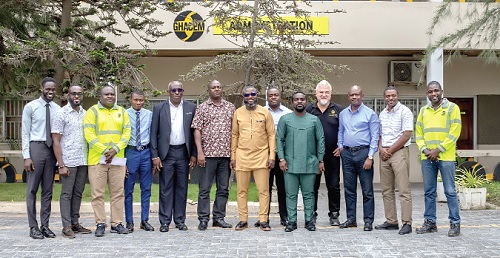|
Getting your Trinity Audio player ready...
|
Cement manufacturer, Ghacem Ltd, is funding a research on the use of cement as a shielding material to reduce the impact of radiation in the radiological industry.
The Department of Physics of the Kwame Nkrumah University of Science and Technology (KNUST) is conducting the research.
It is to investigate and improve the radio-mechanical shielding properties of cement, particularly those produced by Ghacem.
The research is expected to lead to the moulding of light concrete slabs to serve as a shielding material to protect personnel who work with radiation sources from the direct effects of radiation.
Visit
The research team from KNUST paid a working visit to the Ghacem Tema factory recently to present an update on the research and to interact with management on how best to facilitate the project.
The KNUST team was led by Head Nuclear Science and Technology-Department of Physics, Dr Eric Addison, and included lecturers at the Department of Physics, Dr Martin Owusu-Mensah and Joseph Adom.
The team was engaged by top officials of the company, including the Technical Director, Okay Kilinc; the Commercial Director, Kwasi Kyere; the Quality Assurance Manager, John Teye Ohipeni; the Human Resource Director Cluster One, Joel Lawson; the General Manager, WAQL, Eric Amanor, and other managers of various sections of the company.
Shielding critical
Shielding has become one of the critical issues in terms of X-ray facilities, nuclear medicine facility, nuclear power and radiotherapy facility.
Lead has long been considered for radiation shielding in these facilities due to its attenuating properties but it is expensive.
The Ghacem-sponsored research is, therefore, timely to boost the local industry as Ghacem Cement will be considered a cheaper alternative as a shielding material in these industries.
Speaking after the presentations, Mr Kilinc said Ghacem wanted to bring out something useful and innovative for the country, hence the partnership with KNUST on the project.
“We expect that at the end of the project, Ghacem Cement which is a made-in Ghana product will be used to create radiological shields against X-rays or any radiological source to be used in the future nuclear power in Ghana or in the hospitals or research centres.
Radioactive source is dangerous for humans, so by avoiding the expensive method using lead and replacing it with concrete to protect people against radioactivity is economically good.
“As the market leader, we would like to use more locally made products.
We want to stop importation as much as possible.
We want to replace lead which is a scarce product with light-weight concrete to protect people from radioactivity.
Scientific characterisation
For his part, Dr Addison said for some years now the team had been looking at the radiological shielding properties of cement products in the country.
“We sampled cement from various companies looking at the shielding properties and we realised that Ghacem was very promising so we approached the company for partnership/support,” the Head of Nuclear Science and Technology, Department of Physics said.
He said at the end of the research, they hoped to come out with the scientific characterisation of the cement product and how it could be improved upon as shielding properties to both radiomechanical properties and “to really show that Ghacem has something that makes the nuclear and radiological industries very promising in terms of shielding properties.”
Dr Addison thanked Ghacem for its contribution to the Physics Department and the university, saying “this is what we want others to emulate; to really sponsor scientific projects that have direct impact on the local economy”.
Source: myghanadaily


